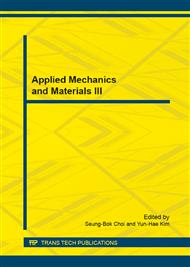p.489
p.497
p.502
p.507
p.511
p.515
p.520
p.524
p.528
Immobilization of Papain on Flexible Magnetic Nanoparticles
Abstract:
Flexible magnetic nanoparticles decorated with dialdehyde starch (DAS) were developed and used as a novel enzyme support for the covalent conjugation of papain. The analyses of Fourier transform infrared (FTIR) spectroscopy confirmed the preparation of magnetic particles with flexible long molecular chains on their surfaces and conjugation of papain with the Fe3O4-DAS nanoparticles. Considering that the immobilized papain was found to exhibit better tolerance to the variations of temperature and medium pH, an advantage of easy to magnetic separation and lack of negative effect on biological activity, the kind of flexible magnetic bioconjugate support should be a good immobilized enzyme carrier, and has potential application in textile, leather, food industries.
Info:
Periodical:
Pages:
511-514
Citation:
Online since:
January 2015
Authors:
Keywords:
Price:
Сopyright:
© 2015 Trans Tech Publications Ltd. All Rights Reserved
Share:
Citation:


